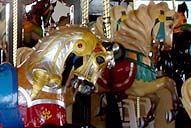




Santa Monica Pier
National Register of Historic Places
Built by Charles Looff


Loof Hippodrome
photo by Michael Grandcolas

Wide view
photo by Michael Grandcolas

Carousel inside Loof Hippodrome

1947 Carousel detail
photo by Michael Grandcolas

Actor William Boyd - Hoppalong Cassidy - 1951

Earlier photo
In ancient Greece, a hippodrome is an open-air stadium with an oval course for horse and chariot races or an arena for equestrian shows. In Santa Monica, the Looff hippodrome is a nationally landmarked structure that might best be described as “a California-Byzantine-Moorish-style fantasy” that sits at the shore end of Santa Monica Pier. This unique structure has been home to a succession of vintage merry-go-rounds and Wurlitzer organs. Back in the early days, the hippodrome was accompanied by the Blue Streak Racer wooden roller coaster and the Whip and Aeroscope thrill rides.
Charles Looff, the man responsible for the hippodrome, is one of this country’s most noted carousel builders. Originator of the Coney Island-style carousel, Looff was born May 24, 1852, in Schleswig-Holstein, Germany, immigrating to the United States in 1870. A furniture builder by trade, he joined the carousel industry in 1875, carving a menagerie of animals from scrap wood gathered from the furniture company where he worked. He opened a shop in Brooklyn and shortly thereafter produced his second carousel, which was installed at Coney Island.
Looff is renowned for innovating a noteworthy style of carousel horse. The moving horses were slender and graceful and inferred motion. The manes featured "cut through" openings, which looked dramatic, but where very time consuming to carve. Around 1905, Looff designed a saddle that resembled a scoop, a design that is still found on carousel horses today.
A success on the East Coast amusement scene, Looff moved to Long Beach in 1911 to focus on the West Coast amusement movement. He was aware of the Santa Monica Pier’s success, and in 1916 reached an agreement with the City of Santa Monica to purchase the northern 200 feet of beachfront property for $50,000 to build a pier alongside the Municipal Pier. The original plans call for a 700-foot long by 200-foot wide amusement pier that would open May 31st. He reported to the Santa Monica business community that he would invest $400,000 in the project and that within a few years he would extend his project further seaward and enlarge it to its current size of 270’ x 1080’.
It has been reported that Looff chose Santa Monica to build his amusement pier because, "the bathing beach at Santa Monica is well-known as one of the finest on the Pacific Coast, it attracts the highest class of people, and transportation facilities afforded are unequaled."
Charles Looff and his two sons Arthur and William arrived to supervise the pier's construction, and promote the details of the Looff Pier’s attractions. Looff announced that he was building the world's largest circle swing and a menagerie animal carousel for his now-famous two-story hippodrome. There was also a racing roller coaster that had been featured at the 1915 San Diego Exposition, a restaurant, and a dance hall.
It opened as scheduled on May 31st, and was more successful than even Looff had imagined. The pier was crowded throughout the summer and on weekends throughout the fall.
Plans were made to build out the pier to 1055 feet and to add new attractions during the winter. A single-story bowling and billiards building, west of the hippodrome, opened on January 17, 1917 and in May they opened a walk-thru fun house. Bands entertained visitors from a platform near the pier's picnic grounds.
In September 1917, Looff incorporated his pier as a public corporation and sold $75,000 in preferred stock. The money was to be used towards building a restaurant building, theater and dance hall. But, only the restaurant was completed when Charles Looff died on July 1, 1918 at age 66. The future development plans for the pier were put on hold.
Looff thrived during the “golden age” of American wooden carousels (early 1800s to early 1930s). As many as 3,000 carousels were produced in the U.S. during that era. Looff operated carousels and major amusements at Santa Cruz, Santa Monica, Redondo Beach, Venice, Ocean Park, and San Francisco. Today, there are less than 175 “golden age” carousels operating.
Records do not indicate what happened to Looff's merry-go-round which was installed in the hippodrome. We do know that it was replaced by one from the old Ocean Park Pier in 1939. The current merry-go-round was built by the Philadelphia Toboggan Company in 1922; its original home was Nashville, Tennessee. The carousel arrived on the West Coast before World War II and in 1947 it was moved from Venice pier to the Santa Monica pier. It has been owned since 1977 by the City of Santa Monica. The 44 original hand-carved and painted wooden horses were restored in 1981-1984.
The Looff Hippodrome carousel building is listed as a National Historic
Landmark. It is rather prominently featured in the Paul Newman and Robert
Redford movie "The Sting."